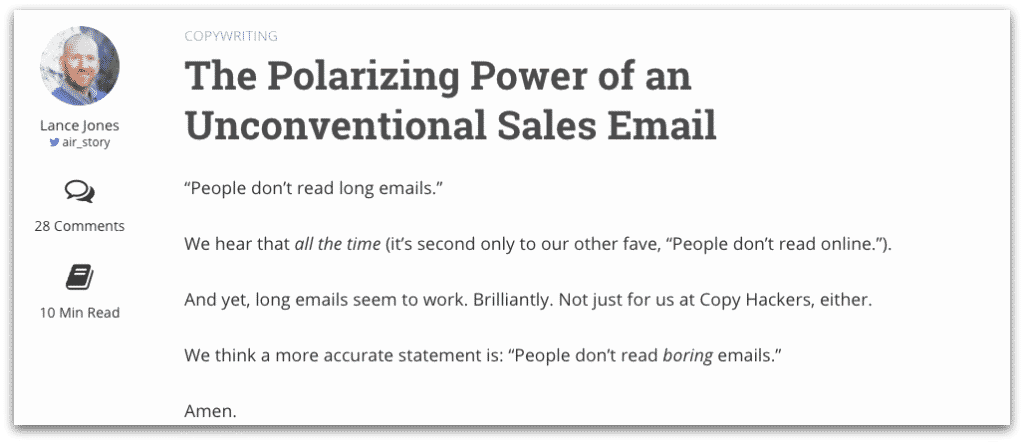Table of Contents:
The Anatomy of a Blog Post: Popular Types of Blog Posts and Why They Convert

Table of Contents:
You already know that blogging is an important cornerstone of any content marketing strategy. Like, you literally don't need us to tell you that at all. But what about the anatomy of a blog post?
When it comes down to the types of blog posts you write, though, you want to get the most bang for your buck - and if you fire up Google and try to figure out the best types of blog posts to write, you'll probably get a lot of conflicting information.
That's because of this little-known industry secret that nobody out there wants you to know: There isn't actually a "right" or "wrong" type of blog post.
It’s a blessing and a curse, really, because you’re not going to find one exact formula that will consistently produce oh-my-god-this-is-amazing results. What you WILL find - and we’ll break it down for you here - are different types of blog posts that have worked really well for a variety of very different people. And what works for one of those people might not work for another, or for you!
One thing that these types of blog posts all have in common? They’re effective at growing and sustaining a reliable audience - so let’s dive right in and examine the anatomy of a blog post that converts!
4 types of blog posts that work
Here are a few different types of blog content your audience will love. Don’t forget to test different types of content and analyze which works best.
1. Shorties
Longer isn't always better - just ask Seth Godin!
This guy is the all-star of the short blog post. Check this thing out:

That's the whole thing - pretty short, right?If you aren’t familiar with Seth Godin, he’s been writing online for a long time. Like, his archives date back to 2002 long. Even in those early days, Seth was writing short-form content.
His motto? “Better write something, better make it good.”
So he writes short, concise blog posts - typically just a few brief, three-sentence paragraphs. He’s the master of making it good in as few words as possible. (He makes up for the brevity by posting something new every day.)
Seth also doesn’t focus too much on SEO - how can he in just a short blog post? Instead, his blog relies on social shares and the occasional viral post, which is a great option for someone so well established in his business.
Maybe those short posts aren’t for you, though - especially because you know that a little attention to keywords and SEO can help you establish your authority even if you’re newer in your industry.
(We can't all be Seth Godin, after all.)If you're ever strapped for an idea that you can spin into a thousand-word post, though, don't feel defeated about writing something more concise!
Why these posts work: They’re to-the-point and written on a super-regular basis (daily, in this case). Subscribers expect to hear from the author often, and they know they’ll be delivered immense value in a short amount of time - the magic formula we all appreciate these days.
2. Long-form posts
The definition of long-form varies, but generally, a blog post you'd consider truly epic is 2,000 words or more. Which is long. (For context, this one is 1,591 words.)
They dive deep on a topic, which means they take a little longer, and are generally posted a little less frequently.
Sumo, for example, has lot's of articles with about 5,000 words long, with all the bells and whistles - headers, subheaders, in-depth examples, screenshots, the works. This kind of article is something Sumo’s known for - deep, deep, deep dives on popular topics that serve their audience of business builders. And these articles do more than just serve the reader - they serve the blog they’re published on, too.
Long-form blog posts increase the amount of time people spend on your website (a factor Google Analytics considers when they look at the success of a site), and it can do a lot to demonstrate your authority on a subject!
(After all, you’re probably not going to try writing a few thousand words about something you don't actually understand. Unless you forgot to study for the AP Shakespeare midterm.)
When you’re creating long-form content, outline your goals for the article before you start writing. Who is going to read it? What will they take away from the article? How will you measure the success of your blog post?
Putting the effort into writing a long piece is well worth it, as long as you know why you’re writing the article to begin with!
Why these posts work: In-depth content that also provides value at every turn can be hard to come by. Long-form content is consumed by dedicated readers who know that they’re getting big takeaways from the article. This type of post is also a great way to convert readers into subscribers!
3. Listicles
Perfected by BuzzFeed and fueled by our addiction to clicking on things (thanks, Internet!), a listicle is really just an article that’s written in list form. These things are such a reliable format that honestly, you can find listicles about listicles. (Ever say a word so many times that it starts to sound really weird? L-I-I-I-I-I-I-ISTICLE.)

Some love 'em, some hate 'em, but no matter how you feel, they're all over the place right now - and there’s no doubt that they can convert.
Listicles are a great way to add highly shareable content to your blog while still providing value to the reader.
Say you're a wedding photographer writing “10 Must-Have Unique Shots For Your Wedding."
Your ideal customer - a couple getting married - will learn about your photography style. You’ll have a chance to show off some of your best work. You can even use the listicle to weed out the customers you don’t want! (Maybe someone wants traditional, while you specialize in candids.)
The trick? Be specific, and put some thought into the value of your list. Don't just slap a bunch of semi-related images and half-baked memes together and call it a day - assemble your work with purpose!
Why these posts work: They’re fun to share, easy to read, and popular on social media. Listicles are a great way to get brand new readers onto your blog - reel them in with a quick read, then hook them with a growing library of quality content.
4. How-to posts
How-to posts, sometimes referred to as explainers, are popular because they give clear, step-by-step instructions on how to get from Point A to Point B. Copyhackers is built on the “tell ‘em what we learned” principle, so how-to articles are the perfect format for their brand of storytelling. Their how-to posts are pretty in-depth, too - check out the read time on this one:

How-to posts build a bond between you and the reader. That post above might not be super relevant to just anyone, but it's been tailored specifically for copywriters - the exact audience for whom Copyhackers creates content.
How-to posts don't always have to start with "How to," though - and they don't have to be thatlong, either.(Because you know the rule about blog posts and string.)Take this one (again, from Copyhackers):

A how-to post is your opportunity not only to impart a lesson, but to share your own experiences - your experiments, your wins, and your well-it-was-worth-a-shot attempts.
Why these posts work: Who doesn’t love a roadmap? If you can take your reader on a journey and create something for them to follow step-by-step, they’ll likely spend some time on your website as they work through that process for themselves.
The more time they spend on your site (and the more successful they are at achieving the results they want by taking your advice), the more likely they are to find out what products and services you offer. When you can deliver them a win with your how-to articles, they more easily grow to know, like, and trust you!
5. Behind the scenes
A behind the scenes post is like a how-to post's cousin - it takes the reader through a process, and shares the results.(And unlike an actual cousin, it never makes a scene at family reunions.)
Taking your readers behind the scenes is distinctly different from giving them instructions, though. Pat Flynn, self-proclaimed “Crash Test Dummy of Online Business,” is famous for taking people behind the scenes of his six-figure business.

Wondering how a post like this might convert people from reader to customer? Check out the number of shares on that post above - and then consider that Pat brings in well over $100k most months because of the links on his blog.
Pulling back the curtain on your business can lead to huge growth in your readership, especially if what you reveal is particularly relevant to your audience.(Want another example? Here's a behind-the-scenes post from our own blog.)
Why these posts work: Facebook, Twitter, Instagram - they are what they are because we love a peek inside the lives of the people around us. Take your reader behind the scenes of your business, and you can strengthen the bond between the two of you. The better they know and understand you, the more they can trust you when it's time to convert!
Technial tips to improve your post
Once you decide which type of blog post you’re going to write, don’t neglect the title and Meta description.
A killer title will get people clicking on your post in the first place. Make it shareable, use alliteration and power words such as ‘exceptional ways to’ ‘the lifechanging benefits of’. With your title, you want to evoke emotion from the reader.
Remember that exceptional copy should be easy to read with concise sentences. Use facts and well-researrched annotations to back up your points. Use open loops where you tease a piece of information that you will answer later in the post.
Don’t forget the power of images and multimedia to enhance your post. These will increase the sharability of your content.Finally, include a clear call to action. What do you want your reader to do once they finish reading your post? Make it obvious.
Subscribe to our newsletter
Are you ready to automate your socials?
Say goodbye to manual scheduling and hello to effortless automation.



